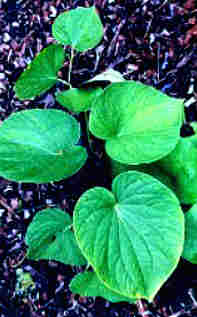
Plant Description
Caution & Interaction

Latin (botanical) name:
Piper Methysticum
Common names: Kava Root, Kava Kava, Ava, Intoxicating Pepper, Ava Pepper
Plant Description: Kava grows abundantly on the islands of Polynesia and in almost all the Pacific islands. Consumption ranged from New Guinea to Hawaii, New Zealand, and most of the Solomon Islands. These days, its use is seen primarily in western Polynesia, especially in Samoa and Tonga, and most of Melanesia, including Fiji. It can also be found in Micronesia. An indigenous shrub several feet high, the leaves are cordate, acuminate, with very short axillary spikes of flowers. The spotted stem is dichotomous. Commercial Kava rhizome is in whitish or grey-brown roughly wedge-shaped fragments from which the periderm is cut off about 2 inches thick; the transverse section usually shows a dense central pith, surrounded by a clean ring of vascular bundles, narrow and radiating, and separated by broadish light-coloured medullary rays. Kava has a faint pleasant odour and the taste is bitter, pungent, and aromatic.
Medicinal Properties &Uses: Oil cells in Kava often contain a greenish-yellow resin, termed kawine, and kavalactones such as kawain, methysticin, and yangonin. It is strongly aromatic and acrid. The plant contains a second resin, a volatile oil, and an alkaloid, Kavaine Methysticcum yangonin, and abundance of starch. Kava is generally used to calm nerves, cause relaxation and sleep, and to fight fatigue. As a drink, it is taken to unclog urinary tracts, to lose weight, and to relieve asthma and rheumatism. It is effective in the treatment of vaginitis, leucorrhoea, nocturnal incontinence and other ailments of the genitourinary tract. Drinking Kava is thought to be good for headaches, cramps, and to cure syphilis and gonorrhea. Many islanders believe kava to restore strength, to soothe stomach pains, and to cure such ailments as boils. Kava is an excellent anti-depressant that elevates moods and sensory perception, diminishes pain, and decreases adrenaline. It is an emotional limbic brain tonic, rejuvenating those under great emotional distress. Studies have compared Kava to anxiety drugs like Valium and Xanax, and found that Kava is as effective as those prescription anxiety agents. But while benzodiazepines (like valium) tend to promote lethargy and mental impairment, Kava has proven to improve concentration, memory, and reaction time for people suffering from anxiety. Kava enhances cognitive function and socialization. It is not addictive, causes relaxation and sleep, relaxes muscles, relieves pain, is anti-convulsant, and is tonic to the stress axis (pituitary, hypothalamus, adrenals) and deep endocrine function.
Dosage: 30-60 drops in water or juice, 2-3 times daily or as needed. Shake well before using.
Cautions & Interactions: Do not take during pregnancy or while nursing. Keep out of reach of children.
Efficacy Studies & Other Clinical Data: Helpful Links:
Disclaimer (U.S. Only): These statements have not been evaluated by the FDA. These products are not intended to diagnose, cure, treat, or prevent any disease.
Common names: Kava Root, Kava Kava, Ava, Intoxicating Pepper, Ava Pepper
Plant Description: Kava grows abundantly on the islands of Polynesia and in almost all the Pacific islands. Consumption ranged from New Guinea to Hawaii, New Zealand, and most of the Solomon Islands. These days, its use is seen primarily in western Polynesia, especially in Samoa and Tonga, and most of Melanesia, including Fiji. It can also be found in Micronesia. An indigenous shrub several feet high, the leaves are cordate, acuminate, with very short axillary spikes of flowers. The spotted stem is dichotomous. Commercial Kava rhizome is in whitish or grey-brown roughly wedge-shaped fragments from which the periderm is cut off about 2 inches thick; the transverse section usually shows a dense central pith, surrounded by a clean ring of vascular bundles, narrow and radiating, and separated by broadish light-coloured medullary rays. Kava has a faint pleasant odour and the taste is bitter, pungent, and aromatic.
Medicinal Properties &Uses: Oil cells in Kava often contain a greenish-yellow resin, termed kawine, and kavalactones such as kawain, methysticin, and yangonin. It is strongly aromatic and acrid. The plant contains a second resin, a volatile oil, and an alkaloid, Kavaine Methysticcum yangonin, and abundance of starch. Kava is generally used to calm nerves, cause relaxation and sleep, and to fight fatigue. As a drink, it is taken to unclog urinary tracts, to lose weight, and to relieve asthma and rheumatism. It is effective in the treatment of vaginitis, leucorrhoea, nocturnal incontinence and other ailments of the genitourinary tract. Drinking Kava is thought to be good for headaches, cramps, and to cure syphilis and gonorrhea. Many islanders believe kava to restore strength, to soothe stomach pains, and to cure such ailments as boils. Kava is an excellent anti-depressant that elevates moods and sensory perception, diminishes pain, and decreases adrenaline. It is an emotional limbic brain tonic, rejuvenating those under great emotional distress. Studies have compared Kava to anxiety drugs like Valium and Xanax, and found that Kava is as effective as those prescription anxiety agents. But while benzodiazepines (like valium) tend to promote lethargy and mental impairment, Kava has proven to improve concentration, memory, and reaction time for people suffering from anxiety. Kava enhances cognitive function and socialization. It is not addictive, causes relaxation and sleep, relaxes muscles, relieves pain, is anti-convulsant, and is tonic to the stress axis (pituitary, hypothalamus, adrenals) and deep endocrine function.
Dosage: 30-60 drops in water or juice, 2-3 times daily or as needed. Shake well before using.
Cautions & Interactions: Do not take during pregnancy or while nursing. Keep out of reach of children.
Efficacy Studies & Other Clinical Data: Helpful Links:
Disclaimer (U.S. Only): These statements have not been evaluated by the FDA. These products are not intended to diagnose, cure, treat, or prevent any disease.